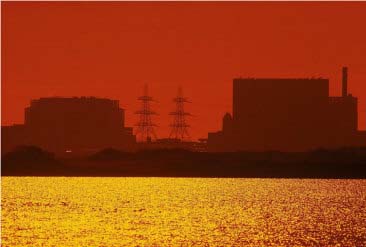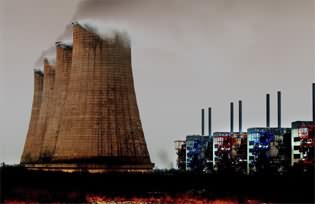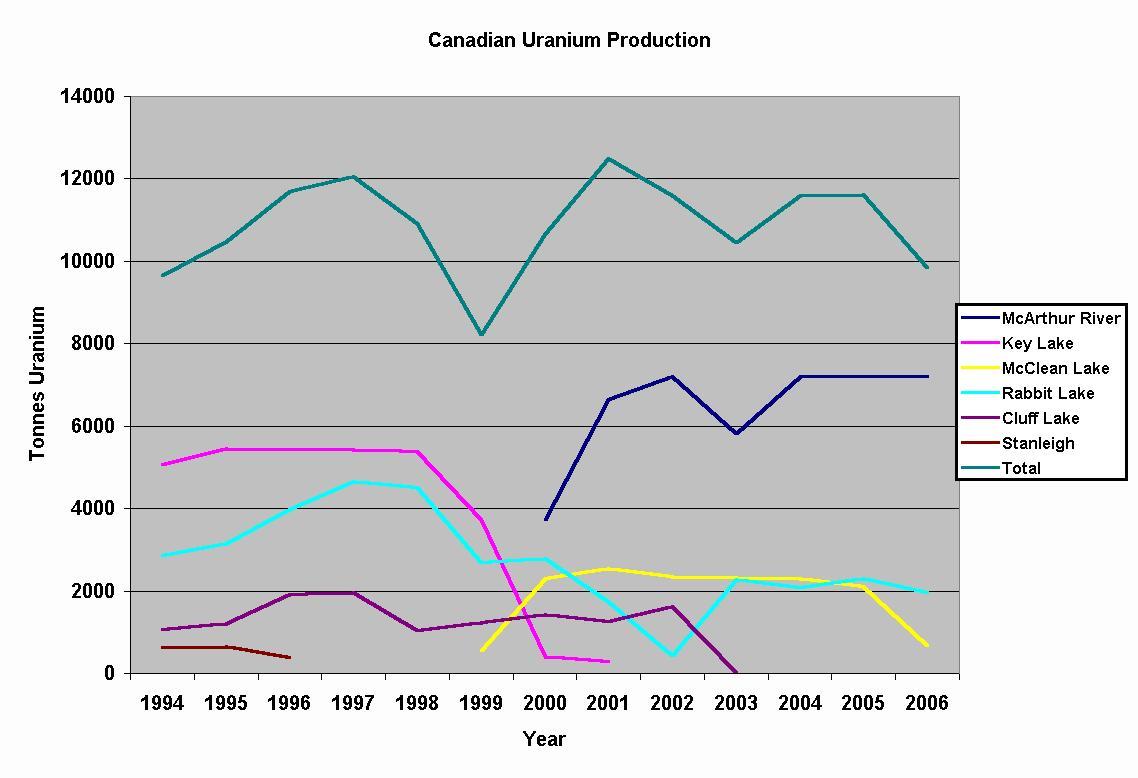 What
is the "one thing" an energy review needs to review? It is the
imminent (or perhaps passed) peak in global crude oil production, on
which the entire world depends for its mobility and its chemicals.
What
is the "one thing" an energy review needs to review? It is the
imminent (or perhaps passed) peak in global crude oil production, on
which the entire world depends for its mobility and its chemicals.
The only reference to a peak in oil production in the 342 pages of "The White Paper on Energy – Meeting the Energy Challenge" is in the Forward by Minister the Rt Hon Alistair Darling MP in which he admits North Sea oil and gas production has hit its peak and is now falling.
The "one thing" that matters, the peaking of global crude oil production, is relegated to obscurity.
The Executive Summary sees but two principle aspects for review:
- Procuring a reduction in carbon dioxide emissions
- Securing imported fuel
Four challenges are considered:-
- How to cut greenhouse gas emissions
- Combat rising fossil fuel prices
- Remaining oil and gas reserves are concentrated in the Middle East, North Africa, Russia and Central Asia
- Need for investment in electricity generation and electricity and gas distribution
The White Paper [1] assumes that world demand for energy will be 50% higher in 2030 than today, but nowhere does it question its ultimate availability, only that an increasing portion of the UK's energy will come from abroad. What it does consider is the security of energy supplies, which are viewed as subject to political interference, rather than question the continued existence of adequate global reserves.
Oil, gas and coal are assumed to play a significant part in meeting the world's energy needs for the foreseeable future and "we need to find ways to reduce their emissions". Planning for a future with but a little oil, gas and coal is not part of the bailiwick. Concerns about climate change and reliance on imported energy subjugate the curtailing of energy use to the bottom of the heap of considerations and even then the aim is to save the planet from warming, not conserve reserves.
The "one thing" that matters, the peaking of global crude oil production, is relegated to obscurity.
Saving energy
Yet the White Paper claims that "the starting point for our energy policy is to save energy". It argues that we need to improve the energy efficiency of products like cars and domestic appliances while pressing for international standards so as to retain trade.
It fails to consider that improving the individual energy efficiency of products simply means that more use of the same can be obtained for the same amount of fuel. If more of the products are used, the savings in energy will be negated and, as the usage may be expanded yet further, more energy will be consumed. Without a limit or restriction on use or modifications in the manner of use, improvements in energy efficiency are ineffective.
 For
example, for a car there is an optimum speed for minimum fuel
consumption. Many modern cars have computers which display the specific
consumption on the instrument panel so that the driver can adjust his
speed to give the maximum fuel economy. The optimum speed is somewhere
around 100 kph or 60 mph. In the UK the dual carriageway limit is 113
kph or 70 mph, but this is regularly exceeded. The imposition of a
European 100 kph (62 mph) speed limit was advocated by Commissioner
Andris Piebalgs in 2005 as a fuel saving and accident reduction measure,
but since then it has seldom been mentioned. It would be possible for
the in-car computer to set the speed of the car automatically to obtain
an optimal fuel consumption. [2]
For
example, for a car there is an optimum speed for minimum fuel
consumption. Many modern cars have computers which display the specific
consumption on the instrument panel so that the driver can adjust his
speed to give the maximum fuel economy. The optimum speed is somewhere
around 100 kph or 60 mph. In the UK the dual carriageway limit is 113
kph or 70 mph, but this is regularly exceeded. The imposition of a
European 100 kph (62 mph) speed limit was advocated by Commissioner
Andris Piebalgs in 2005 as a fuel saving and accident reduction measure,
but since then it has seldom been mentioned. It would be possible for
the in-car computer to set the speed of the car automatically to obtain
an optimal fuel consumption. [2]
Cars imported from Germany have electronic speed governors set to a limit of 250 kph (155 mph), but these could readily be set to say 120 kph (75 mph) for use in the UK or could be set at a standard 100 kph in Europe as a global warming alleviation measure.
A search for the word "speed" through the White Paper finds that although it is accepted that in the area of transport "the behaviour of individuals could make a large impact" it is only used in reference to speeding up administrative procedures.
 There
are many activities that could be modified to produce a reduction in
fuel use. For instance Formula One racing in itself consumes vast
amounts of fuel and rubber, but the attendance of spectators and
commentators uses the most. Its defence is that it provides a test bed
for engine and components, but other development methods would use less
fuel. It could be restricted to bio-fuels as a means of developing
better engines for carbon-neutral alternatives to oil-based fuels, but
currently it mainly inspires "boy racers" and the use of over-engined
cars on the roads.
There
are many activities that could be modified to produce a reduction in
fuel use. For instance Formula One racing in itself consumes vast
amounts of fuel and rubber, but the attendance of spectators and
commentators uses the most. Its defence is that it provides a test bed
for engine and components, but other development methods would use less
fuel. It could be restricted to bio-fuels as a means of developing
better engines for carbon-neutral alternatives to oil-based fuels, but
currently it mainly inspires "boy racers" and the use of over-engined
cars on the roads.
As far as energy saving is concerned, in the White Paper it has to conform to "business-as-usual" or more so and sees no need to incite the inevitable "road rage".
Clean energy supplies
Having failed to make any suggestions as to how human behaviour might be modified, or even needs to be, the Executive Summary turns to the provision of cleaner energy supplies.

Incontrovertible is the provision of microgeneration in which householders add wind, solar and ground-sourced heat pumps to their premises with the incentives of lowering their energy bills and even passing their surplus to the grid for remuneration.
Biomass use is seen to be carbon neutral, because the carbon is fixed first from the atmosphere before combustion. In this category is wood-fired domestic boilers. The use of biomass for the production of liquid fuels is controversial, because supplies of vegetable oils are grown on land needed for food crops.
It assumes that decentralised energy will grow alongside the centralised system, but with the latter clearly occupying the cockpit of the battle for "business-as-usual". Large scale electricity generation is to come from renewables, clean coal and nuclear power.
Clean coal with carbon sequestration can be dismissed because on a theoretical basis it requires the combustion of between 27% to 37% more coal for the same electrical generation, which in practice would mean that up to 50% more coal would have to be mined. The loss of a third of their coal production to clean coal technology would be unacceptable to countries like China and Ukraine where its underground mining is costly in lives and where it provides the energy of economic growth. The government is launching a competition to demonstrate commercial scale carbon capture and storage, but there are no likely winners if the fundamental mass and thermal balances are taken into account. [3]

This leaves renewables like solar, wind and sea currents on the one hand and nuclear power on the other. The renewables and nuclear lobbies are at odds, fearing that funds devoted to one will be denied to the other. The nuclear lobby attacks the wind lobby on its variability, forgetting that nuclear has the opposite disadvantage in that at night when consumption is low it cannot be readily turned off. Pumped storage systems and cross-channel "power-swaps" together with night storage domestic heaters at a lower charge were introduced to ameliorate this nuclear disadvantage. There is virtually some wind in every part of the UK, so the answer to variability is the grid and additional pumped storage into which water can be lifted when the wind blows. [4]
Both renewables and nuclear suffer from the need for subsidies. Obligatory supplements for the augmentation of conventional fuels are imposed in the case of the former, while unwarranted carbon credits based on false claims of low carbon operation will be passed to the latter. The onset of peak oil, together with the imminence of peak gas and coal, means that as fossil fuel reserves decline the burden of high fuel costs would be laid on conventional generators and industrial consumers. They would be quite unable to pay the additional levies on their carbon emissions needed to provide the credits for their allegedly "clean" competitors.
Also as the actual amount of carbon produced from declining reserves will also be reducing, the tradable carbon would be inadequate to sustain the agencies created for the purpose. The Hadley Centre projections and the Stern "economics" depend on a "never-emptying porridge pot of fossil fuels" as does the Kyoto concepts and all are flawed.
The only real "clean" energy comes from the renewables sector, but its supply is probably limited to around 20% of the current electricity generation. To supplant fossil fuel generation an impossible level of renewables would be needed. Energy for transport from renewables will be also be marginal and should be confined to supplying rail and tramways which make the best use of it.
Hydrogen is mostly produced from natural gas, so that for carbon-free operation it would have to be produced by electrolysis, which together with the energy needed for its liquefaction is very inefficient. Nuclear power provides only 6% of the world's primary energy, or a mere 2½% as electrical energy, so that it has no chance of making an adequate contribution to transport by hydrogen production.

Nevertheless the White Paper was basically written to re-introduce nuclear power in an attempt to maintain "business-as-usual". Since uranium is 100% imported and in shortage, it offers no additional security of supply. An expanded nuclear sector cannot compensate for depleting oil reserves while its fuel supplies are subject to the same depletion process.
Nuclear power
The White Paper assumes that nuclear power is a "low carbon source" of energy, even though over the various consultations and correspondence many attempts have been made to show that when all the elements of the overall nuclear fuel cycle have been taken into account, this is far from being the case. The decrease in the available grades of uranium ores as the higher grades become exhausted means that over time there is a progressive increase in carbon emissions from the overall fuel cycle.
An economic "cut-off" occurs well before a point is reached when so much material has to be moved and processed that the energy required for the mining and milling, added to the other energy inputs to the fuel cycle, exceeds the electrical energy output. At the "cross-over" point when the energy inputs exceed the output, the carbon emissions resulting from the energy inputs would equate or exceed those of a gas-fired station, but a mining economic "cut-off" would rule before it was reached.
The low carbon status of nuclear power is an essential element of the White Paper strategy, because it can in theory earn its carbon credits at the expense of fossil fuel users, in effect robbing Peter to pay Paul. In practice nuclear power would not earn all of its claimed credits if the emissions in the fuel manufacturing and uranium source countries are taken into account.
The UK nuclear power programme from its inception in 1956 up to its anticipated generating end in 2035 and beyond that into the next century with its waste management has been and will be a financial disaster. It will cost consumers and taxpayers a staggering £150 billion for electricity worth £50 billion. A token of this emerged with the privatisation of electricity generation and distribution, which led to the need for government intervention to rescue British Energy from bankruptcy. The French apparently buoyant nuclear industry, embracing generation, station and fuel manufacture is predominantly state-owned and would never have emerged without state capital.
 But
the crux of the matter is the availability of uranium, which like the
other energy minerals, oil gas and coal, is subject to the Hubbert
bell-shaped curve of a production rise, peak and decline. Apart from
Kazakhstan, primary uranium mining production is declining, while the
secondary supplies of ex-weapons material and inventories are dwindling.
Global primary production, which only provides 60% of the demand, fell
by 5% in 2006 from that in 2005, because of a 15% fall in Canada and a
20% fall in Australia which together provide more than half. [5]
But
the crux of the matter is the availability of uranium, which like the
other energy minerals, oil gas and coal, is subject to the Hubbert
bell-shaped curve of a production rise, peak and decline. Apart from
Kazakhstan, primary uranium mining production is declining, while the
secondary supplies of ex-weapons material and inventories are dwindling.
Global primary production, which only provides 60% of the demand, fell
by 5% in 2006 from that in 2005, because of a 15% fall in Canada and a
20% fall in Australia which together provide more than half. [5]
If there is to be a nuclear "renaissance" in which the number of operating stations increases, either by new build (promoted all over the world) or by extending the lives of the present fleet, the current uranium primary production has to double within the next decade, to cater for increased demand and to replace the secondary sources. The only project of any size, the Olympic Dam mine expansion as an open pit in South Australia, capable of providing around 20% of the world demand in 2014 when (and if) it opens on schedule, depends for its viability on the co-products of copper, gold and silver. If there is no world recession by then and the price of copper allows it to pass its feasibility study in 2009 and go ahead, its contribution to uranium supply will be insufficient to sustain the aspirations of so many candidate nations.
The White Paper accepts the fallacious claims of the industry manual, the "Red book" published by OECD/NEA, arguing that rises in its price will allow uranium reserves to expand as the lower grades of ore become economic. Reserves of an energy resource are of no use and will remain in the ground unless the energy required to extract and utilise them is much less that that subsequently provided. Individual mines exhibit their Hubbert production peak curves and eventually the aggregate of all the mine curves will provide a global peak. [6]
This has been masked by past stagnation and the use of the secondary sources, but a uranium peak will soon be evident. A plot of the production history of the Canadian mines below illustrates the applicability of the Hubbert curves well.

Nuclear power's dying years will be characterised by the withdrawal of
failed aging reactors and by a lack of fuel, while the
"renaissance" will stall.
falsus in unum, falsus in omnibus
The most significant event in modern economic history will be the passing of the "all-oils" peak in the sum of conventional and non-conventional oil production. In the UK the passing of the North Sea oil peak has resulted in dependency on external supplies and for the moment its purchasing power will allow its economy to grow.
Gas, coal and uranium will be unable to substitute efficiently for the loss in the supply of liquid fuels with disastrous consequences for the motor and aviation industries. A marginal reduction in supply will restrict movement, but road and air traffic growth absolutely, so that orders for vehicles and aircraft will be cancelled. There will be no need for road improvements and more runways, so construction contracts will be cancelled or at least postponed.
There are many unnecessary activities relying on oil products, such as motor sport and air travel which will be sacrificed in order for a reasonable life to continue, but the consequences of government obfuscation of the real issue will be catastrophic. The White Paper, while acknowledging the passing of the UK oil peak has failed to consider the consequences of a global oil peak, preferring to divert attention to the secondary problem of global warming; secondary because the depletion of fossil fuel reserves, of which oil is the primary concern, will progressively reduce the engine of climate change.
By being false in this "one thing" it is false in everything else, including its promotion of nuclear power, for which it was designed to re-introduce.
[1] http://www.dti.gov.uk/files/file39387.pdf
[2] http://www.lowcvp.org.uk/assets/other/lowcvp_challenge_booklet.pdf
Paper 4, page 28 /PDF 36
[3] http://web.mit.edu/coal/The_Future_of_Coal.pdf
[4] http://www.eci.ox.ac.uk/publications/downloads/sinden05-dtiwindreport.pdf
[5] http://www.world-nuclear.org/info/uprod.html
[6] http://www.energiekrise.de/uran/docs2006/REO-Uranium_5-12-2006.pdf